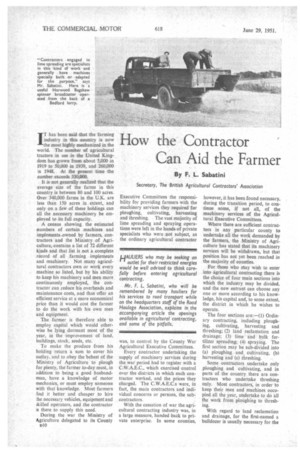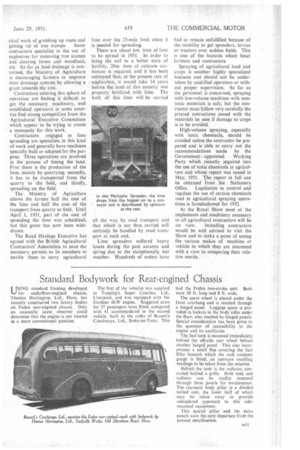How the Contractor Can Aid the Farmer
Page 68

Page 69

If you've noticed an error in this article please click here to report it so we can fix it.
By F. L. Sabatini
Secretary, The British Agricultural Contractors' Association
IT has been said that the farming industry in this country is now the most highly mechanized in the world. The number of agricultural tractors in use in the United Kingdom has grown from about 5,000 in 1919 to 50,000 in 1939, and 260,000 in 1948. At the present time the number exceeds 330,000.
It is not generally realized that the average size of the farms in this country is between 80 and 100 acres. Over 340,000 farms in the U.K. are less than 150 acres in . extent, and only on a few of these holdings can all the necessary machinery be employed to its full capacity.
A census showing the estimated numbers of certain machines and implements -owned by farmers, contractors and the Ministry of Agriculture, contains a list of 72 different kinds and that list is not a complete record of all farming implements and machinery. Not many agricultural contractors own or work every machine so listed, but by his ability to keep his machinery and men more continuously employed, the contractor can reduce his overheads and maintenance costs, and thus offer an efficient service at a more economical price than it would cost the farmer to do the work with his own men and equipment.
The farmer is therefore able to employ capital which would otherwise be lying dormant most of the year, in the improvement of land, buildings, stock, seeds, etc.
To make the produce from his holding return a sum to cover his outlay, and to obey the behest of the Ministry of Agriculture to plough for plenty, the farmer to-day must, in addition to being a good husbandman, have a knowledge of motor mechanics, or must employ someone with that knowledge. Most farmers find it better and cheaper to hire the necessary vehicles, equipment and ;killed operators, and the contractor is there to supply this need.
During the war the Ministry of Agriculture delegated to its County D10 Executive Committees the responsibility for providing farmers with the machinery services they required for ploughing, cultivating, harvesting and threshing. The vast majority of lime spreading and spraying operations were left in the hands of private specialists who were not subject, as the ordinary agricultural contractor was, to control by the County War Agricultural Executive Committees.
Every contractor undertaking the supply of machinery services during the war period had to register with a C.W.A.E.C., which exercised control over the districts in which each contractor worked, and the prices they charged. The C.W.A.E.C.s were, in fact, the main contractors and individual concerns or persons, the subcontractors.
With the cessation of war the agricultural contracting industry was, in a large measure, handed back to private enterprise. In some counties, however, it has been found necessary, during the transition period, to continue some, if not all, of the machinery services of the Agricultural Executive Committees.
Where there are sufficient contractors in any particular county to undertake all the work demanded by the farmers, the Ministry of Agriculture has stated that its machinery services will be withdrawn, but that position has not yet been reached in the majority of counties.
For those who May wish to enter into agricultural contracting there is the choice of four main sections into which the industry may be divided, and the new entrant can choose any one or more according to his knowledge, his capital and, to some extent, the district in which he wishes to operate.
The four sections are:—(1) Ordinary contracting, including ploughing, cultivating, harvesting and threshing; (2) land reclamation and drainage; (3) lime and bulk fertilizer spreading; (4) spraying. The first section may be sub-divided into (a) ploughing and cultivating, (b) harvesting and (c) threshing.
Some contractors undertake only ploughing and cultivating, and in parts of the country there are contractors who undertake threshing only. Most contractors, in order to keep their men and machines occupied all the year, undertake to do all the work from ploughing to threshing.
With regard to land reclamation and drainage, for the first-named a bulldozer is usually necessary for the chief work of grubbing up roots and getting rid of tree stumps. Some contractors specialize in the use of explosives for removing tree stumps and clearing forest and woodland, etc. So far As land drainage is concerned, the Ministry of Agriculture is encouraging farmers to improve their drainage systems by allowing a grant tOwards the cost.
Contractors entering this sphere of operation are finding it difficult to get the necessary machinery, and established operators in some counties find strong competition from the Agricultural Executive Committees which appear to be trying to create a monopoly for this work.
Contractors engaged in lime spreading are specialists in this kind of work and generally have machines specially built or adapted for the purpose. Three operations are involved in the -process of liming the land. First there is the production of the lime, mainly by quarrying; secondly, it has to be,.transported from the quarry to ' the field, and thirdly, spreading on the field.
The Ministry of Agriculture allows the farmer half the cost of the lime and half the cost of the transport from quarry to field. Until April 1, 1951, part of the cost of spreading the lime was subsidized, but this grant has now been withdrawn.
The Road Haulage Executive has agreed with the British Agricultural Contractors' Association to issue the necessary permits to its members to enable them to carry agricultural lime over the 23-mile limit when it is needed for spreading.
There are about 6m. tons of lime to be spread in 1951. In order to bring the soil to a better state of fertility, 28m. tons of calcium carbonate is required, and it has been estimated that, at the present rate of application, it would take 14 years before the land of this country was properly fertilized with lime. The bulk of this lime will be carried all the way by road transport and that which is not thus carried will certainly be handled by road trans port at each end.
Lime spreaders suffered heavy losses during the past autumn and spring due to the exceptionally wet weather. Hundreds of orders have had to remain unfulfilled because of the inability to get spreaders, lorries or tractors over sodden fields. This is one of the hazards which beset farmers and contractors.
Spraying of agricultural land and crops is another highly specialized business and should not be undertaken by unskilled operators or without proper supervision. So far as the personnel is concerned, spraying with low-volume machines with nontoxic materials is safe, but the contractor must follow very carefully the printed instructions issued with the materials he uses if damage to crops is to be avoided.
High-volume spraying, especially with toxic chemicals, should be avoided unless the contractor be prepared and is able to carry out the recommendations made by the Government appointed Working Party which recently inquired into the use of toxic chemicals in agriculture and whose report was issued in May, 1951. The report in full can be obtained from the Stationery Office. Legislation to control and regulate the use of certain chemicals used in agricultural spraying operations is foreshadowed for 1952.
At the Royal Show most of the implements and machinery necessary to all agricultural contractors will be on view. Intending contractors would be well advised to visit the Show and to make a point of seeing the various makes of machine or vehicle in, which they are interested with a view to comparing their relative merits..












































































































































